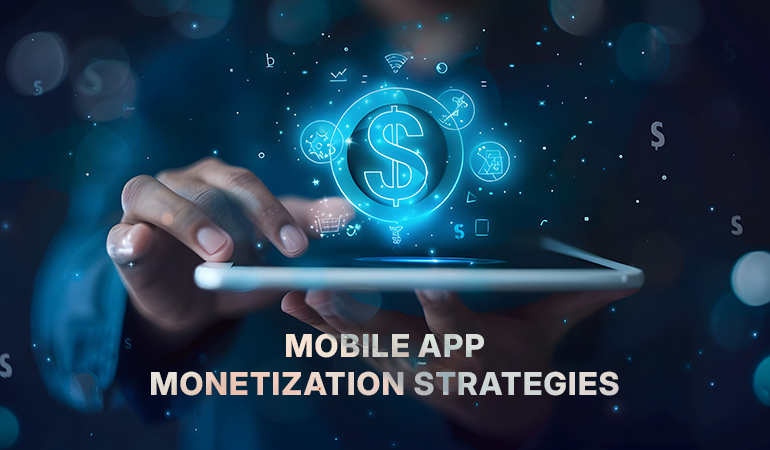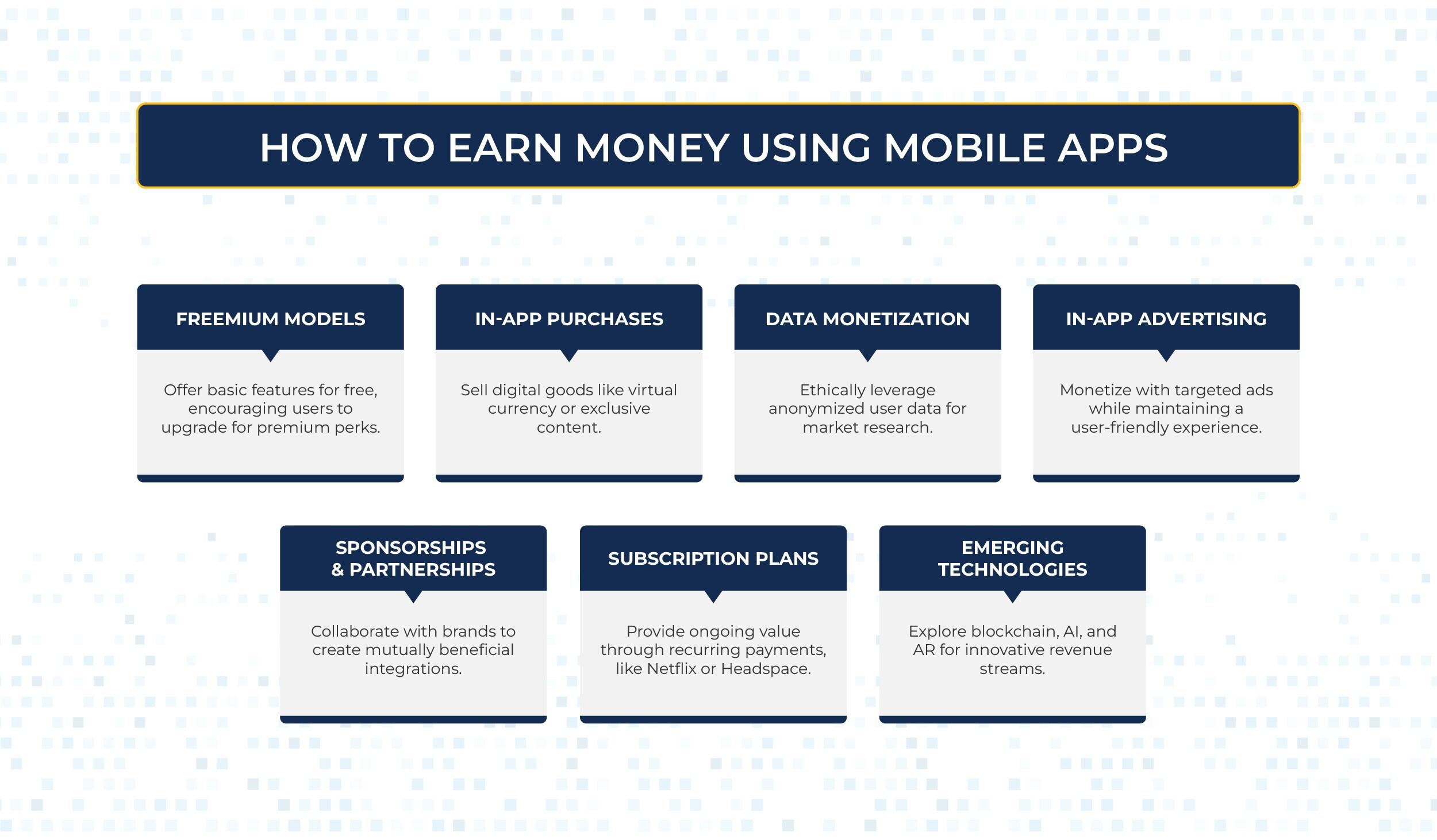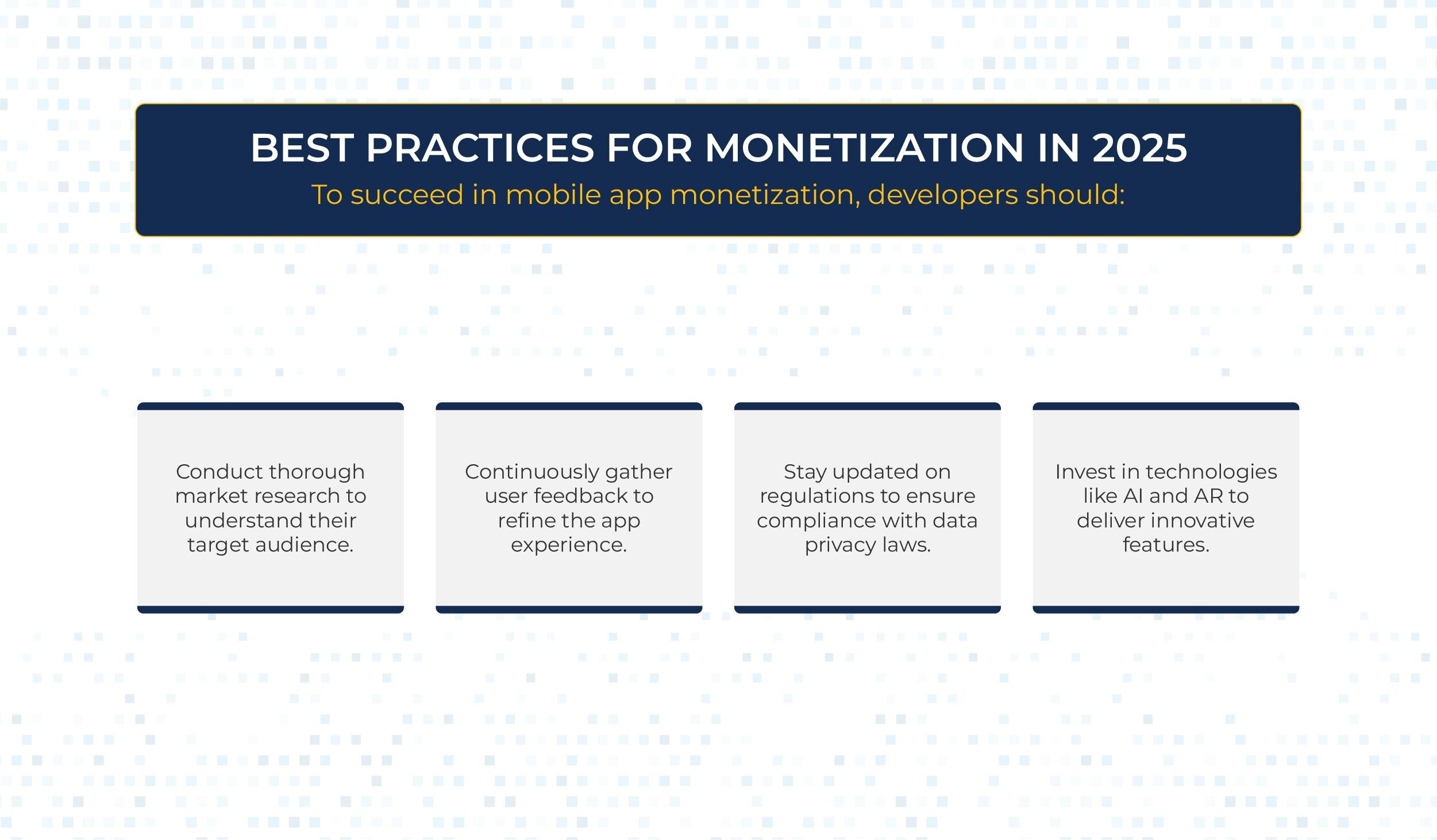How to Earn Money with Mobile Apps: Top Monetization strategies

Mobile apps have become integral to our daily lives, spanning industries such as entertainment, productivity, healthcare, and e-commerce. However, creating a successful mobile app isn’t just about building something useful or engaging—it’s about finding the right way to monetize it.
With user behavior and technology continuously evolving in affordable mobile app development, mobile app monetization strategies must adapt to stay effective.
How to Earn Money Using Mobile Apps
You can earn money through application development services and creative monetization strategies that align with your app’s purpose and audience. Whether you’re developing a gaming app, a fitness tracker, or a productivity tool, these approaches can help you generate sustainable revenue:
Focusing on user engagement and staying updated on industry trends can turn your app into a profitable venture while offering a seamless user experience.
Mobile App Monetization Strategies
Here’s a detailed look at the mobile app monetization strategies that are making waves in 2024.
-
Freemium Model
The freemium model continues to dominate mobile app monetization. The app is free to download and use in this approach, but certain features, content, or services are locked behind a paywall.
What Works:
- Offer core functionality for free while showcasing the value of premium features.
- Examples: Spotify, which provides free streaming but charges for ad-free listening and offline downloads.
2024 Insights:
- Focus on AI-driven personalized experiences in the premium tier.
- Bundle premium features with subscription services for added value.
Freemium apps succeed when they balance accessibility with enticing upgrades. Highlighting user benefits through well-crafted free experiences remains crucial.
-
Subscription-Based Model
Subscriptions have significantly increased as users prefer predictable, recurring payments for apps they use regularly.
What Works:
- Offer tiered pricing to cater to different user needs.
- Examples: Netflix, which provides content streaming based on subscription levels.
2024 Insights:
- Leverage hybrid subscriptions (e.g., combining fitness apps with wearables).
- Use free trials effectively to convert users into subscribers.
Innovation is driving the subscription model’s growth. Apps offering more value through personalization or bundled services will likely have higher retention rates.
-
In-App Advertising
Advertising remains a staple, especially for free-to-download apps. The challenge lies in balancing ad placements without alienating users.
What Works:
- Use non-intrusive ad formats like native ads and rewarded video ads.
- Examples: Mobile games offering extra lives or bonuses for watching ads.
2024 Insights:
- AI-driven ad personalization can significantly improve user engagement.
- Implement ad frequency caps to avoid overwhelming users.
Modern in-app advertising leverages data-driven insights to align ads with user interests, ensuring better engagement and revenue without disrupting user experiences.
-
In-App Purchases (IAP)
In-app purchases enable users to buy digital or physical items directly within the app, making this a lucrative option for apps in gaming, e-commerce, and content delivery.
What Works:
- Offer a mix of consumable (e.g., game currency) and non-consumable items (e.g., permanent upgrades).
- Examples: Clash of Clans, which generates revenue through in-game items.
2024 Insights:
- Integrate augmented reality (AR) for virtual goods in apps.
- Create time-sensitive offers to boost engagement.
Gamification paired with exclusive in-app purchases keeps users invested in their experience, driving sustained revenue growth.
-
Paid Apps
Although less popular, paid apps can still work if they provide unique value or cater to a niche market.
What Works:
- Justify the price with exclusive features or premium content.
- Examples: Procreate, which charges a one-time fee for advanced digital art tools.
2024 Insights:
- Combine the paid model with optional IAPs for added revenue streams.
While challenging to scale, paid apps thrive when they serve targeted audiences or deliver unmatched quality.
-
Sponsorship and Partnerships
Sponsorship involves collaborating with brands to integrate their content or services within your app. This works well for apps with a strong niche audience.
What Works:
- Feature branded content or co-create campaigns with partners.
- Examples: Fitness apps collaborating with health supplement brands.
2024 Insights:
- Use influencer marketing within apps to increase sponsorship value.
- Provide sponsors with detailed user analytics for better ROI.
Sponsorships allow for a steady income stream while aligning your app with complementary brands that enhance user trust and engagement.
-
Crowdfunding
Crowdfunding is an alternative route for unique or community-driven apps. Platforms like Kickstarter and Patreon help developers secure funding directly from users.
What Works:
- Build a loyal community by offering early access or exclusive perks.
- Examples: Indie apps focused on education or creativity.
2024 Insights:
- Use social media to engage directly with potential backers.
- Leverage subscription crowdfunding for ongoing development support.
Community-driven cross platform mobile development often uses crowdfunding to maintain development transparency and foster user loyalty.
-
Data Monetization
Data monetization involves leveraging anonymized user data for analytics or market research.
What Works:
- Ensure transparency and comply with data privacy regulations (e.g., GDPR, CCPA).
- Examples: Apps offering insights based on aggregated user behaviour.
2024 Insights:
- Offer users the option to opt-in for data sharing in exchange for premium features.
Ethical data mobile app monetization strategies must prioritize user consent and clear communication with privacy concerns growing.
-
Blockchain-Based Monetization
Blockchain is reshaping how apps handle transactions, ownership, and rewards.
What Works:
- Use cryptocurrencies or NFTs for transactions within the app.
- Examples: Gaming apps offering unique NFTs as rewards.
2024 Insights:
- Explore decentralized finance (DeFi) features for user rewards.
- Ensure a seamless user experience for blockchain-based transactions.
The blockchain offers an innovative approach to mobile app monetization by empowering users with ownership and transparency.
-
Emerging Technologies in Monetization
2024 is witnessing the rise of new technologies influencing monetization strategies.
- AI and Machine Learning: Personalization driven by AI helps target users with tailored offers, ads, and in-app experiences, maximizing conversions.
- AR and VR: Immersive technologies are opening new gaming, retail, and education revenue streams.
- Voice Commerce: With smart devices becoming more prevalent, voice-enabled apps explore voice commerce as a monetization tool.
Case Studies and Real-World Examples
To better understand how these cross platform mobile development and mobile app monetization strategies work in practice, let’s explore a few real-world success stories:
- Duolingo: This language-learning app leverages the freemium model with ads for free users and subscription plans for those who want an ad-free experience with additional perks like offline access.
- Fortnite: Known for its in-app purchases, Fortnite offers cosmetic items and battle passes that keep users engaged without making the gameplay pay-to-win.
- Headspace: A subscription-based meditation app that uses free trials and personalized recommendations to convert users into paying subscribers.
Best Practices for Monetization in 2025 
By combining these practices with a well-chosen monetization strategy, apps can achieve sustainable growth while maintaining high user satisfaction.
Final Thoughts
Choosing the right monetization strategy depends on your app’s audience, industry, and core value proposition. In 2024, the emphasis is on user-centric approaches that balance revenue generation with excellent user experiences.
Whether you opt for subscriptions, ads, or cutting-edge blockchain solutions, staying adaptive and innovative will be the key to success in the ever-evolving mobile app ecosystem.
Mobile app monetization is no longer a one-size-fits-all approach. It demands a deep understanding of market trends, user preferences, and technological advancements.
Developers for cross platform mobile development and businesses that prioritize user satisfaction while exploring diverse revenue models will remain at the forefront of this dynamic industry.
If you need further help in cross platform mobile development and mobile app monetization, you can contact us at [email protected]. We will schedule a free consultation session to explore how Xavor can assist you in this matter.
https://www.xavor.com/wp-content/uploads/2025/02/mobile-app-monetization-strategies-fi.jpg
2025-02-06 06:39:42




